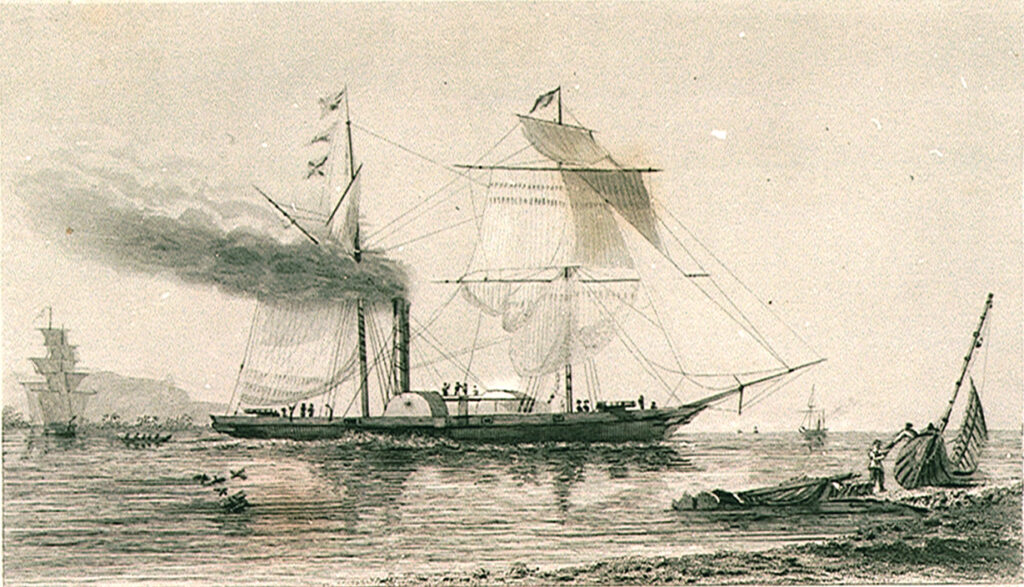In 1904, the SS Nemesis sank and disappeared almost entirely. All lives on board were lost.
Not too long after, the bodies of the Nemesis’s crew and debris from the lost ship began to watch up on the Australian shore. Despite this, the wreck of the Nemesis was never found, and for 120 years, the mystery of its sinking and final resting place endured.
Finally, in 2022, the Nemesis reappeared. At first, its discovery was an accident, but after more intensive research it became clear that the infamous coal ship that had been lost off the Melbourne coast had finally been found.
Let’s dive a little deeper into the last few hours of the Nemesis, its rediscovery, and what the newly-found sunken ship has revealed about its sinking.

What Happened to the SS Nemesis?
The SS Nemesis was an experienced and trusted ship by the time it was loaded with coal on July 9, 1904. The ship had made the trip from Newcastle to Melbourne multiple times, and its crew had no reason to think anything was amiss.
SS Nemesis was first launched in 1880 out of Melbourne, the same city it would be traveling to on its final voyage. In the beginning, it was a coiler, or coal ship, before being refitted to serve as a passenger transport during an Australian gold rush. When the gold rush sputtered out, the Nemesis was transformed back into a coiler, which it would remain for the rest of its working life.
Trouble came when the weather turned as the Nemesis approached the Australian coast. An unexpected storm spun to life, catching the Nemesis off guard. The final sighting of the Nemesis was by another ship also caught in the terrible weather, but while that ship made it out, the Nemesis did not.
News of the coiler’s sinking spread quickly, but despite efforts to locate the ship, no trace was found. Weeks later, pieces of the Nemesis, along with the water-logged corpses of some of its crew began to wash up on the shores of Cronulla Beach. It would be the last pieces seen from the Nemesis for over a century.
The Rediscovery of the SS Nemesis
Oddly enough, no one was actually looking for the Nemesis when it was found. The company that stumbled across the wreckage did so completely by accident.
In 2022, an underwater surveying and salvage company called Subsea Professional Marine was searching for lost shipping containers off the coast of Sydney, Australia. These shipping containers can be lost off cargo ships and are incredibly valuable. Subsea Maine was using underwater imaging to locate these containers when they instead found something much, much older.
The images displayed to the survey company were clearly a shipwreck, but they had no way to tell what ship it was. It was found 16 miles from shore, 525 feet below the surface.
In order to identify the shipwreck, the Commonwealth Scientific and Industrial Research Organization, or CSIRO was brought in. CSIRO, considered one of the best science agencies in Australia, would set out to do their own imaging with the explicit goal of identifying the mystery shipwreck.
Even before CSIRO set out, the scientists had a hunch that the ship may have been the lost Nemesis. The shipwreck was clearly old, and the location matched up with the last known sighting of the Nemesis. Preliminary imaging from Subsea wasn’t enough for a conclusive identification, though, so CSIRO needed more.
Instead of just taking imaging from the surface, CSIRO used an underwater research vessel called the RV Investigator, to go beneath the wave and capture images of the wreckage. The Investigator also implemented echosounders to create a 3D map of the shipwreck.
These 2D and 3D images were compared to old pictures and paintings of the steamship, and everything lined up. Many of the features that made the Nemesis unique were able to be identified on the shipwreck, and it was enough proof to make the declaration everyone had been hoping for:
The SS Nemesis had finally been found.
Why Did the SS Nemesis Sink?
Once the shipwreck was identified, the first order of business was to inform the living families of the Nemesis crew that the ship had been located. It was much-needed closure for many, and the end of a mystery that had haunted them for over a century.
After the families had been informed, there was another question to be answered: how exactly did the Nemesis sink?
CSIRO, using the RV Investigator, was able to collect enough 3D imaging to construct a 3D model of the sunken ship, so it could be researched without anyone having to descend to the wreckage.
It had always been assumed that a storm was the downfall of the SS Nemesis, but it was important for scientists to confirm this theory. Knowing the fate of the Nemesis wasn’t just important for history, but for the surviving family members, too.
With the newly created 3D model, it was determined that a storm truly was what sealed the fate of the coiler. Careful investigation revealed that the steam engine powering the ship had become overwhelmed by the storm, especially the waves, and quickly failed.
Without its engine, the Nemesis was stranded, unmoving, in the horrible storm. Enormous waves battered the ship, and finally, one was large enough to take the Nemesis down.
The sinking happened so fast and was so unexpected, that it was impossible for the crew to launch the much-needed lifeboats. Unfortunately, even if they had succeeded, the lifeboats wouldn’t have stood much of a chance in weather violent enough to sink an entire steamship, anyway.
All hands on deck were lost due to the unexpected squall, huge waves, and failure to launch lifeboats that all occurred simultaneously. But thanks to a coincidental finding by Subsea Marine, and the hard work of CSIRO, the crew of the Nemesis can finally find peace.

